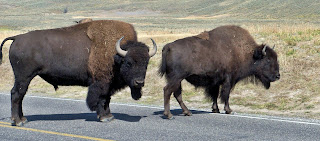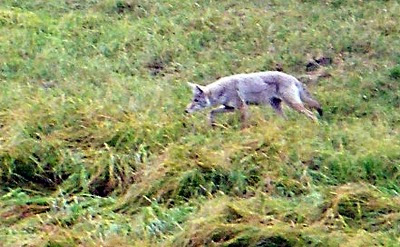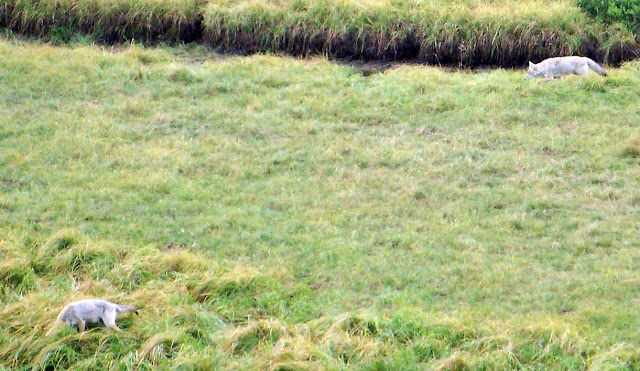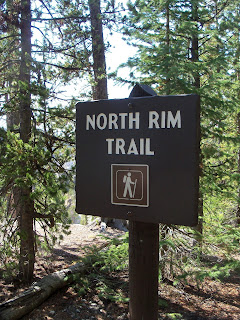 |
| An 8-foot stack of sun-bleached bones outside Charlie's antler emporium. . |
He also set down a large blue and white checked cloth neatly folded and tied at the corners which he untied to display the contents: a small bundle of dry mesquite wood, some rice, beans, onions and chunks of meat.
"All I need is a pot to cook 'em in," he said.
"Where are you from?" I asked. "And did you walk?"
"Redding. Redding, California. Walked most of the way," he said. "Hitched a few trains too."
The odd thing about Freddie was that he was neat and clean. Not at all the stereotypical hobo. His hair was cut, his beard trimmed. He looked about 45. His backpack frame and its contents all clean if not spanking new. No smell of sweat, drink or cigarettes.
"What are you doing?" I asked. "Camping by the river." he replied. He surveyed his stash of food and wood lying on the ground. "Just need a pot to cook in," he repeated. "I'll bring it back," he said imploringly. "I'll find some wire and ball it up and scrub it clean."
It was, I decided, worth the gamble. I brought out my old Coleman cooking pot and lid and offered it to him. He accepted. "I'll bring it back," he promised.
"What are the odds he'll bring it back?" I asked my friend standing next to me. "About one in three against," she said.
I watched him disappear into the night. It was the last time I saw my pot.
The trouble with being on the road and owning and living in a VW bus is that no one works on them any more. Well, hardly anyone. In Las Cruces, NM, there is Tunie. He was recommended by a garage in Truth or Consequences as about the only one left within a hundred miles who works on aircooleds.
I'd beat the bus up pretty bad in the summer, driving it hard in hundred degree temps on mountain roads. I figured new heads at least for openers, but never got around to starting the project, and now fall is coming and I need something reliable and was willing to pay if only I could find someone to do it.
It was about 70 miles straight down from TorC to exit 9 on I-25 and then a three or four mile jag down some back roads Tuesday to get to Tunie's, a soft-spoken man well into his years, from Mexico, with some 42 years of VW wrench turning under his belt. His house, he said, was the pink one at 145 San Ysidora Road.
I didn't need a mailbox or house color to find it. Tunie's was the dwelling with a dozen dead and dying VWs in various stages of decay in the front. I had made an appointment. Tunie was expecting me.
He ambled out, a big man, walking slow. His eyes twinkled. "Nice bus," he said. I thanked him.
He nodded. After some talk I left things in his care. Three days, he said, to pull the engine, rebuild the top end, test it, tune it and get it back to me. That was Tuesday.
Thursday came and Tunie called. He had an eye infection and couldn't work, a patch on one eye. I took him at his word. On Saturday I dropped by. There was my engine now disassembled, and Tunie, eye-patch removed, going over each part and examining it with loving care. We fell into talking VW. "Take your time," I told him, my faith in the soft-spoken man growing. "Whatever it needs do it. I want to be able to drive to the Pacific Northwest this fall. And across country." His eyes twinkled. 'When I am finished you will be able to drive anywhere without worry for years."
That's what I wanted to hear. Keep wrenching, Tunie. You are part of a dying breed.
I met Charlie an hour our so outside of Yellowstone National Park in Montana on the way to Cody. It wasn't hard to meet Charlie. An eight-foot stack of sun-bleached skulls and antlers in front of his barn/workshop announces his presence just off the highway.
Charlie in his youth had been a roustabout in the oil fields of Montana until the fields shut down. With a home and family to support, he looked for a way to make a living, selling arrowheads and souvenirs to tourists heading to and coming from nearby Yellowstone. It was slim pickings at first. So Charlie enlarged the menu, adding furs, knick-knacks, stuffed animals, mounted heads.
But the breakthrough came when Charlies discovered some folks just like antlers. And there were plenty of them around for the taking. Elk and moose and deer shed their antlers annually. Soon Charlie had more antlers than he could use. What to do with them all?
 |
| Charlie's antler chandelier. |
"I guess I created this industry," he says. "It's kind of a recycling these things one last go."
Growing antlers each year is a nutritional drain on large cervids such as elk, moose and deer. They grow rapidly and require lots of food intake.
Charlie rubs his chin philosophically. "It's a shame to see all that natural effort go to waste."
Out in front the stack of bleached bones, skulls and antlers testifies to nature's bounty. "And they can be pretty and useful too."
About Antlers—Antlers serve many functions, from fighting to adornment. Reindeer in the north use antlers to clear ice and snow when foraging for food. But perhaps none is more unusual than that of the moose. Studies show a moose without a rack does not hear as well as its horned brethren. The antlers serve the moose, among other things, scientists believe, as a giant parabolic sound reflector.
JNR






















